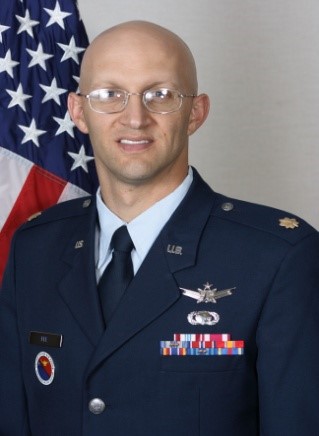Seminar: James R. Fee, Air Force Institute of Technology (AFIT)
| Event Date: | February 22, 2017 |
|---|---|
| Speaker: | Lieutenant Colonel James R Fee Jr. |
| Speaker Affiliation: | Air Force Institute of Technology (AFIT). |
| Time: | 3:30 p.m. |
| Location: | PHYS 112 |
| Contact Name: | School of Nuclear Engineering |
| Contact Phone: | (765) 494-5739 |
| Contact Email: | ne@purdue.edu |
| Open To: | Undergraduate students, graduate students |
| Priority: | No |
| School or Program: | Nuclear Engineering |
| College Calendar: | Show |
 Lieutenant Colonel James R Fee Jr.
Lieutenant Colonel James R Fee Jr.
Engineering Physics Department
Air Force Institute of Technology (AFIT)
Title
Modeling the White Sands Missile Range Fast Burst Reactor with a Discrete Ordinates Code, PENTRAN[1]
Abstract
The Fast Burst Reactor (FBR) on White Sands Missile Range, N.M. produces a fast fission neutron flux that is useful to expose a variety of test articles to high energy neutrons for a multitude of scientific research applications. The FBR has been modeled by the Monte Carlo code, MCNP, to simulate the flux at various test locations within the facility to predict total dose and dose rate measurements. AFIT is exploring the differences and similarities between a Monte Carlo and discrete ordinates simulation of the reactor using the Parallel Environment Neutral-Particle Transport (PENTRAN) Code to compare against MCNP simulations. AFIT has recently acquired the neutral particle transport software, Parallel Environment Neutral-Particle Transport Code (PENTRAN) from the Air Force Technical Applications Center (AFTAC). PENTRAN was first developed by the AFTAC Chief Scientist, Dr. Glenn Sjoden, in 1995 and has been continually updated and enhanced since inception. Because operating the FBR is an expensive, a simulation capability to predict the neutron flux that will pass through a test article prior to conducting an experiment will ensure that the test article receives the desired exposure. Additionally, computing resources were provided by the Department of Defense (DoD) Supercomputing Resource Center (DSRC) at the Air Force Research Laboratory (AFRL). During this research endeavor a PENTRAN model of the FBR will be created and flux calculations will be carried out on the DSRC platform, SPIRIT. Below right is a two dimensional model of the FBR showing the burst and control rods removed showing PENTRAN’s modeling capability, and left is a flux plot of this model for the 1.9205 MeV energy group showing PENTRAN’s flux calculation potential. Subsequently, a comparison of MCNP flux calculations and on-site dosimeter readings will be made against PENTRAN flux calculations. Finally, conclusions will be drawn regarding the merit of using PENTRAN as a flux calculation supplement to the MCNP models for the purpose of designing useful FBR experiments.


References: [1]G. E. Sjoden, “PENTRAN Code System Users Guide to Version 9.4X.5 Series.” HSW Technologies.
Biography
Lieutenant Colonel Fee is an Assistant Professor of Nuclear Engineering in the Engineering Physics Department of the Air Force Institute of Technology (AFIT). He completed his doctorate degree in nuclear engineering with a specialty in nuclear weapon effects simulation in September 2015. Lieutenant Colonel Fee conducted computational research for his dissertation by modeling the effects of Electromagnetic Pulse from a nuclear weapon detonation in the atmosphere.
Lieutenant Colonel Fee received his commission through the Reserve Officer Training Corps at Purdue University upon his graduation in December 1997. He began his career with training to be an Intelligence officer. Upon graduation from intelligence training in Dec 1998, he was assigned to the Air Force Technical Applications Center (AFTAC) at Patrick AFB, Florida. As Chief of Information Operations, he was second in command for a team of over 40 enlisted personnel operating AFTAC’s 24-hour-a-day data collection system from a global network of sensors. In June 2000, he was selected to attend graduate school at the Air Force Institute of Technology (AFIT) at Wright Patterson AFB. Upon graduation in March 2002, he was assigned to the 526th ICBM Systems Wing at Hill AFB, Utah. There he was responsible to manage Electromagnetic Pulse testing for the Minuteman (MM) III missiles to ensure the MM fleet was properly hardened against a Nuclear Attack on the United States. In February 2004, Major Fee was selected to become the Executive Officer to the Commander, 526th ICBM Systems Wing. After serving as an executive officer for a year, he was selected for special duty assignment as a strategic nuclear analyst for the Central Intelligence Agency in McLean, Virginia. In Nov 2007, he moved to the Defense Threat Reduction Agency at Fort Belvoir, VA to work as the Program Manager of the Advanced Electronics program. As program manager, he was responsible for ensuring radiation hardened electronics were available for the Air Force’s missile systems as well as GPS satellites. He was selected to become an instructor at the Squadron Officer School in June 2009 at Maxwell AFB, AL. In Mar 2010, he was selected to become the Operations Officer for the 29th Student Squadron at the Air and Space Basic Course. In Aug 2010, he deployed to Baghdad, Iraq for 6 months where he served as an Intelligence Advisor to the Iraqi Air Force under OPERATION IRAQI FREEDOM. In July 2011, he began his studies as a student at Air Command and Staff College at Maxwell AFB, AL. Upon graduation in July 2012, he was selected to attend a residence program for doctoral studies. Prior to his current assignment, he was a PhD student in the faculty pipeline program to the AFIT.
Read Lt. Col. Fee's complete biography here:
2017-02-22 15:30:00 2017-02-22 16:30:00 America/Indiana/Indianapolis Seminar: James R. Fee, Air Force Institute of Technology (AFIT) PHYS 112
